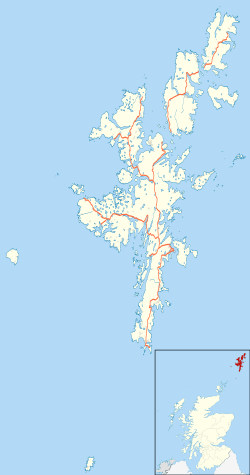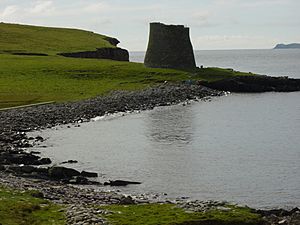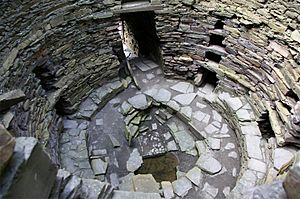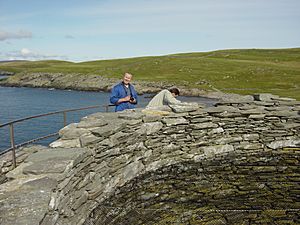Broch of Mousa facts for kids
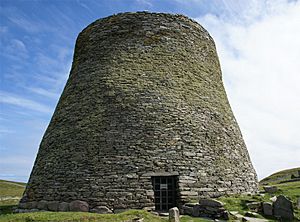
Mousa Broch exterior
|
|
| Location | Mousa, Shetland |
|---|---|
| Coordinates | 59°59′43″N 1°10′55″W / 59.9952664°N 1.1820277°W |
| Type | Broch |
| History | |
| Periods | Iron Age |
| Site notes | |
| Ownership | Historic Environment Scotland |
The Broch of Mousa (also called Mousa Broch) is a very old stone tower from the Iron Age. You can find it on the island of Mousa in Shetland, Scotland. It's the tallest and best-preserved ancient building of its kind in Europe. This amazing tower was built around 100 BC. There were once over 500 such towers, called brochs, in Scotland! Today, Historic Environment Scotland looks after this important historic site.
Contents
Where is Mousa Broch?
The Broch of Mousa stands on the western shore of Mousa island. You can reach it by boat from Sandwick, Shetland, which is about 23 kilometers (14 miles) south of Lerwick. It sits on a flat rocky area right by the sea, looking out over Mousa Sound.
What Does Mousa Broch Look Like?
Mousa Broch is quite special because it has very thick walls. This strong build, along with its quiet location, is why it's still in such great shape today. The tower stands about 13.3 meters (44 feet) tall. You can go inside through a single entrance at ground level. Once you are inside, you can even climb an old staircase all the way to the top!
This broch is made of dry stone, meaning no cement was used to hold the stones together. The entrance is on the west side. It has a long passage, about 5 meters (16 feet) long, and still has an original bar-hole. This hole was likely used to secure a wooden bar across the door.
Inside the Broch
Inside the main area, you can see a hearth (a fireplace) and a floor tank. There's also a low stone bench around the inside wall. This bench was added later.
The broch was used for a long time. At first, it might have had a wooden house inside. Later, this wooden building was replaced by a small stone wheelhouse. This wheelhouse had three stone walls sticking out from the center.
There are also three large rooms built into the thick walls of the broch. You enter these rooms through doorways that are about 0.7 meters (2.3 feet) above the floor. Above these doorways, there are openings to let in light and air. Each of these rooms has small storage spaces, like cupboards, built into the wall.
Above the solid base of the broch, there are six galleries. These are like walkways between the two circular walls of the tower. They are partly lit by openings. You can walk along most of these galleries. They were probably used by the builders to help construct the tower, not for living or storage.
The staircase starts on the second level. You reach it through a doorway in the inner wall. There's also another room higher up, above the entrance passage.
Mousa Broch Through History
Mousa Broch was used for many centuries. It's even mentioned in two old Norse Sagas (Viking stories)!
One story, Egil's Saga, tells about a couple who ran away from Norway to Iceland. Their ship was wrecked, and they used the broch as a safe place to stay for a while. The Orkneyinga Saga tells of a battle at the broch in 1153. Earl Harald Maddadsson attacked the broch because his mother was being held inside it.
Many people have visited and studied Mousa Broch over the years. George Low made the first drawings of it in 1774. Sir Walter Scott visited in 1814 and called it "the most entire [Pictish] fortress probably in the world."
Discoveries and Repairs
In 1861, workers cleaned out the broch. They found many animal bones, especially from otters, who probably lived there when it was empty. They also found pieces of a clay pot, stone pot lids, and a carved model of a boat. The inside was cleaned again in 1919, but not many new things were found. Some pottery pieces from the 19th-century cleaning are now in the National Museum of Scotland in Edinburgh. The broch also had major repairs from 1967 to the 1980s to keep it standing strong.
In 2005, archaeologists used 3D laser scanning to study the broch in great detail. This helped them plan for any future repairs.
Home to Storm Petrels
Mousa Broch is famous among birdwatchers because of the European storm petrels that nest there. These small birds are best seen after dark on cloudy summer nights. The island is home to about 6,800 pairs of these birds. This is about 8% of all the storm petrels in Britain and 2.6% of the world's population! Some of these birds even make their nests in burrows right inside the broch walls.
Images for kids
See also
 In Spanish: Broch de Mousa para niños
In Spanish: Broch de Mousa para niños


